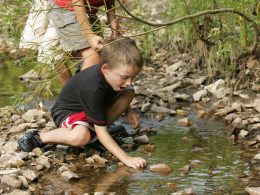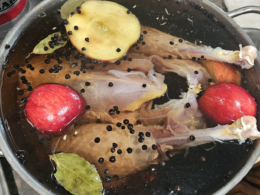Many people have deemed this plant a pesky weed that needs to be exterminated. However, dandelions are a superfood that nature provides us with. The entire dandelion plant, including the roots, is edible and has a lot of benefits. In this article, we’ll unlock the nutritional power of dandelions, and how to use them to empower your diet. We’ll cover how to forage them. How to use them in medicinal recipes. And how to harvest the potent nutrients of dandelions.

There is something special about spring. I always enjoy watching life emerge from its winter slumber. Witnessing new growth daily until the outdoors is covered in lush greenery. We will be reaping the first fruits of spring soon! One of the first items ripe for foraging is dandelions. Dandelions are a staple for your backyard medicine kit and wild edible pantry. My kids like to make drinking straws out of them. I clip the ends and rinse them in a vinegar water bath. The straws are just fun, but there are countless other recipes I could share from baked goods to soaps! Foraging wild plants are a fun way to involve the family in outdoor activity. As an outdoor enthusiast, who is also a mom, these are the activities I love to have my kids participate in. It not only sparks a love for the outdoors, but it also helps them connect nature to their food and medicine. These playful days gathering plants will create life-long wilderness skills. Where ever spring takes you I hope it gets you future out in nature.
Table of Contents
Foraging Dandelions
Gathering wild food is a fun activity to start in the spring. When foraging, always follow a few “rules.” First, know the area you are foraging from. You will want a clean source free from chemical sprays to gather your wild plants. Next, be able to identify the wild plant you are seeking out. Some plants have toxic look-a-likes or only parts of the plants are edible. Thankfully, dandelions are easily recognizable and grow in abundance.
For most dandelion recipes, you’ll want plants that have not “grown to seed”, meaning they have not yet grown a stem and have not developed the white rounded top, full of flying seeds. Look for the small, yellow flower buds. If you see that recognizable white puff ball kids like to blow into the air, the stem, and roots are probably too bitter for most folks to enjoy.
Leaves, Roots, & Stems
The leaves of the dandelion plant can be used in salads and sautéed similar to spinach. It is best to harvest the leaves in spring for the longer the plant lives the more bitter the leaves become. Additionally, the roots can be harvested, roasted, and consumed. They hold medicinal properties. Many people create a dandelion tincture using both roots and leaves. The sap from the stems can be used to treat warts, calluses, corns, and rough skin.
Dandelion Tea

Dandelion tea has many health benefits. Dandelions contain vitamins A, C, E, and K as well as some smaller amounts of vitamin B. They also contain minerals such as potassium, magnesium, iron, and calcium. Dandelions have been known to help with digestion issues, lower blood pressure, and even cancer. There are numerous other health benefits to consuming dandelions. Drinking tea is a fast way to absorb the nutrients for medicinal benefits. You can dehydrate the petals and store them in an airtight container for long-term storage. Dehydrate petals on the herb setting of your dehydrator.
INGREDIENTS
- 2 Tbsps Distilled Vinegar
- 1.5 Tbsps Dried Dandelion Petals per 8oz Boiling Water
- Ice & Sweetener if Making Iced Tea
INSTRUCTIONS
- Gather your dandelion flower heads. If you’ve gathered whole plants, remove the stem and seed pod, just below the yellow flower head.
- Rinse the heads. I like to fill a large bowl of water and add a couple of tablespoons of distilled vinegar as a disinfectant or to kill any lingering ants.
- Boil water.
- Pour boiling water into a glass bowl. For every 8 oz of boiling water, add 1.5 Tbsps of dandelion flower heads.
- Steep for five to ten minutes.
- Strain the tea to separate the petals from the liquid.
- If making iced tea, transfer tea to a large glass pitcher and refrigerate for four to thirty-six hours. Add your favorite sweetener to bring out the refreshing flavor of the tea.
Dandelion Jelly

Fun fact: in the past, dandelion jelly was often referred to as the “poor man’s honey.” Interestingly, it does have a very similar taste to wild honey. Dandelions grow wild across the American landscape. You will want to gather them early in full yellow bloom before they grow to seed. For the best dandelion jelly, use lush yellow petals.
NOTE
For this recipe, you’ll be making a strong, concentrated dandelion tea. You will need at least 1 qt. of petals. You can follow the recipe above, using 1 qt of petals and 2 qt of boiling water. The tea will need to steep for 12-24 hours. I normally allow it to cool on the counter and continue steeping overnight in the refrigerator.
You’ll also need water bath canning supplies. Water bath canning is the process of preserving food, in glass jars. They are sealed by the pressure the boiling water creates.
INGREDIENTS
- 2 qt of Concentrated Dandelion Tea (see recipe above)
- 2 tbsp Lemon Juice
- 1 Box Powdered Fruit Pectin
- 4 1/2 C Sugar
- Sterilized Canning Jars
INSTRUCTIONS
- Transfer dandelion tea to a clean saucepan. Set stovetop to medium-high heat.
- Add 2 tbsp of lemon juice and stir in one packet of powdered fruit pectin. Stir to combine.
- Add 4 1/2 cups of sugar and continue to stir as you bring it to a boil.
- Once boiling, continue stirring for 3 minutes.
- Pour the liquid jelly into warm, sterilized canning jars. Be sure to wipe the rims on the lip of the jars with a clean damp towel. I always dap the paper towel in vinegar and wipe the rim for added disinfectant.
- Place a new flat on top and finger-tighten the bands.
- Process the jars for 10 minutes in a hot water bath.
- After the processing time is complete, remove the jars and allow them to cool on a rack or towel for 24 hours.
- After 24 hours, check to make sure each jar has been sealed properly. Remove bands and clean jars with soapy water, dry them, and store them in the pantry.
- Always label and date your jars. For jars that did not seal correctly, place them in the refrigerator for immediate use. Sealed jars will keep for 12 to 18 months.
Dandelion Arthritis Salve

Dandelion flowers have anti-inflammatory and pain-relieving properties. Creating salve out of the flowers can be used for your everyday aches and pains. It can also be good for moisturizing and anti-itch cream. I also add sweet orange essential oil to help with absorption and lavender essential oil to help with relaxation. For added pain relief strength, add Youngliving’s Panaway oil or any pain-relieving essential oil.
INGREDIENTS
- 1 C Dandelion flower
- 1/4 C Vinegar
- 1/2 C Olive or Jojoba Oil
- 4oz Glass Jar
- 1 tbsp Beeswax Pellets
- 1 tbsp Shea Butter
- 6 Drops Sweet Orange essential oil
- 6 Drops Lavender essential oil
- OPTIONAL: 20 Drops Panaway or Pain Relief Oil
INSTRUCTIONS
- For this recipe, you can leave the green seedpod intact and discard any leaves and stems.
- Rinse 1 C dandelion flowers with 1/4 C vinegar in a large bowl.
- Fill a glass jar with dandelion flowers and leave about an inch.
- Pour 1/2 C oil to cover the tops of the dandelions.
- Seal and place the jar in a dry dark space for 2-6 weeks. Be sure to shake occasionally, every other day.
- After the infusing time has passed, strain petals from the oil using cheesecloth. Discard the petals.
- Pour dandelion oil into a cooking pot over medium-high heat.
- Add 1 tbsp of beeswax pellets and stir until melted.
- Add 1 tbsp. Shea butter and stir until melted.
- Add 6 drops of each of the essential oils, and if chosen to do so, 20 drops of pain relief oil. Mix well.
- Pour salve mixture into the jar. Allow to cool until firm.
- Use salve as needed for pain, moisturizer, and anti-itch cream. External use only.
Have you Changed your Mind About Dandelions?
Hopefully, you no longer think of the dandelion plant as a pesky weed that needs to be exterminated. And maybe you learned something new about one of nature’s superfoods. Are you going to try to forage any dandelions and try out any of the recipes? Sound off in the comments!








